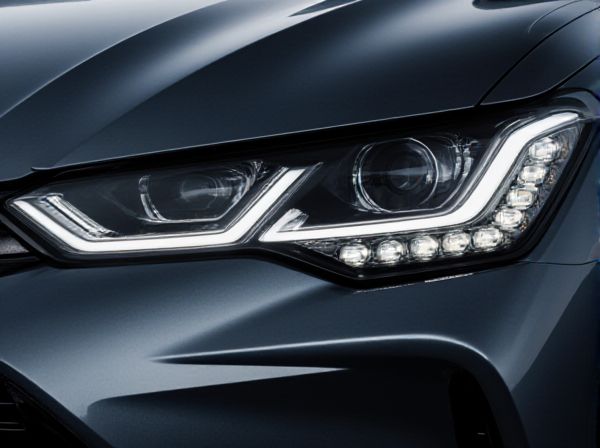
Photo illustration: Matrix Headlight vs Adaptive Headlight
Adaptive headlights adjust their beam direction based on your driving conditions and steering input, enhancing visibility around curves and during turns. Matrix headlights use multiple LED segments that can selectively dim or brighten to avoid glaring other drivers while maximizing road illumination. Your choice depends on whether you prioritize dynamic beam adjustment or advanced glare control for safer night driving.
Table of Comparison
| Feature | Matrix Headlight | Adaptive Headlight |
|---|---|---|
| Definition | Uses multiple LED segments to control light distribution precisely. | Automatically adjusts beam direction based on steering and speed. |
| Technology | LED matrix with individual pixel control. | Motorized adjustment of reflector or projector headlights. |
| Light Management | Blocks or dims specific areas to avoid glare while maintaining high-beam. | Shifts entire beam to follow road curvature and traffic. |
| Safety | Enhances visibility without dazzling other drivers. | Improves night driving safety by illuminating curves and turns. |
| Cost | Higher due to advanced LED technology. | Moderate, uses existing headlight mechanics. |
| Common Use | Premium vehicles with advanced lighting systems. | Mid to high-range vehicles with adaptive lighting. |
Introduction to Modern Headlight Technologies
Matrix headlights utilize multiple individually controlled LEDs to provide precise light distribution, enhancing visibility without blinding other drivers. Adaptive headlights automatically adjust the beam direction based on vehicle speed, steering angle, and road conditions to improve safety during cornering and driving on varying terrains. Both technologies represent advancements in automotive lighting aimed at optimizing illumination and driver awareness in diverse driving environments.
What is a Matrix Headlight?
Matrix headlights utilize an array of individually controlled LEDs to adjust the beam pattern precisely, enhancing nighttime visibility without dazzling other drivers. These smart lighting systems dynamically block or dim specific light segments to adapt to oncoming traffic and road conditions. Unlike traditional or adaptive headlights, matrix headlights offer superior customization and safety by selectively managing light distribution in real-time.
How Adaptive Headlights Work
Adaptive headlights use sensors and cameras to monitor driving conditions, such as speed, steering angle, and ambient light, adjusting the headlight beams accordingly to enhance visibility and safety. These headlights pivot or change light intensity automatically to illuminate curves, hills, or oncoming vehicles without blinding other drivers. Unlike Matrix headlights that selectively block out sections of the beam, adaptive headlights focus on dynamic beam adjustment to optimize road illumination.
Key Differences: Matrix vs Adaptive Headlights
Matrix headlights use multiple LED segments to precisely control light distribution, enhancing visibility without blinding other drivers. Adaptive headlights mechanically adjust the beam direction based on steering and vehicle speed to improve illumination around curves and turns. Both technologies improve safety, but matrix headlights offer more granular light control and dynamic beam shaping compared to the broader adjustment of adaptive headlights.
Illumination Performance and Visibility Comparison
Matrix headlights utilize multiple LED segments to selectively illuminate road areas, minimizing glare while enhancing visibility around curves and obstacles. Adaptive headlights adjust their beam direction based on steering input and vehicle speed, improving illumination in turns but with less precise light distribution than matrix systems. Matrix technology generally offers superior illumination performance by dynamically controlling light patterns, leading to enhanced safety and clearer visibility in diverse driving conditions.
Safety Benefits: Matrix vs Adaptive Headlights
Matrix headlights enhance safety by actively adjusting the beam pattern to avoid blinding other drivers while maintaining maximum illumination on the road, using multiple LEDs and sensors for precise control. Adaptive headlights improve safety by swiveling the light in response to steering input and vehicle speed, aiding driver visibility around curves and during turns. Matrix technology offers superior safety benefits compared to adaptive headlights by providing more dynamic and granular light distribution, reducing glare and increasing nighttime driving visibility.
Technological Components and Design
Matrix headlights incorporate multiple LEDs arranged in segments, controlled by sensors and cameras to selectively dim or illuminate sections, enhancing visibility without glaring other drivers. Adaptive headlights use swiveling projector units and sensor data from steering, speed, and elevation to dynamically adjust beam direction according to road curves and vehicle movement. Technological components in matrix systems emphasize precise LED modulation and advanced digital controls, while adaptive designs rely on mechanical actuation and real-time environmental feedback for beam adaptation.
Common Applications and Availability
Matrix headlights are commonly used in high-end luxury and performance vehicles, offering precise light distribution by selectively dimming individual LEDs to avoid blinding oncoming traffic. Adaptive headlights are widely available across mid-range and premium cars, utilizing swiveling lamps or variable beam patterns to enhance visibility around curves and during turns. Both technologies improve nighttime safety, but Matrix headlights are typically found in newer models with advanced driver assistance systems.
Cost and Maintenance Factors
Matrix headlights feature individual LED segments that can be expensive to repair or replace due to their complex technology and high initial cost, often ranging from $1,000 to $2,500 per unit. Adaptive headlights use a simpler mechanism with swiveling components, generally resulting in lower maintenance costs and more affordable replacements, typically between $300 and $700. Long-term maintenance of matrix headlights requires specialized service and software updates, increasing overall ownership expenses compared to adaptive headlights.
Choosing the Right Headlight for Your Vehicle
Matrix headlights use multiple LED segments to selectively illuminate the road, enhancing visibility while preventing glare for oncoming traffic. Adaptive headlights adjust the beam direction in response to steering input and vehicle speed, improving safety by illuminating curves and turns more effectively. Choosing the right headlight depends on your driving environment and budget; matrix headlights offer advanced glare control ideal for urban and highway driving, while adaptive headlights provide enhanced corner lighting beneficial for winding roads.
 caratoz.com
caratoz.com